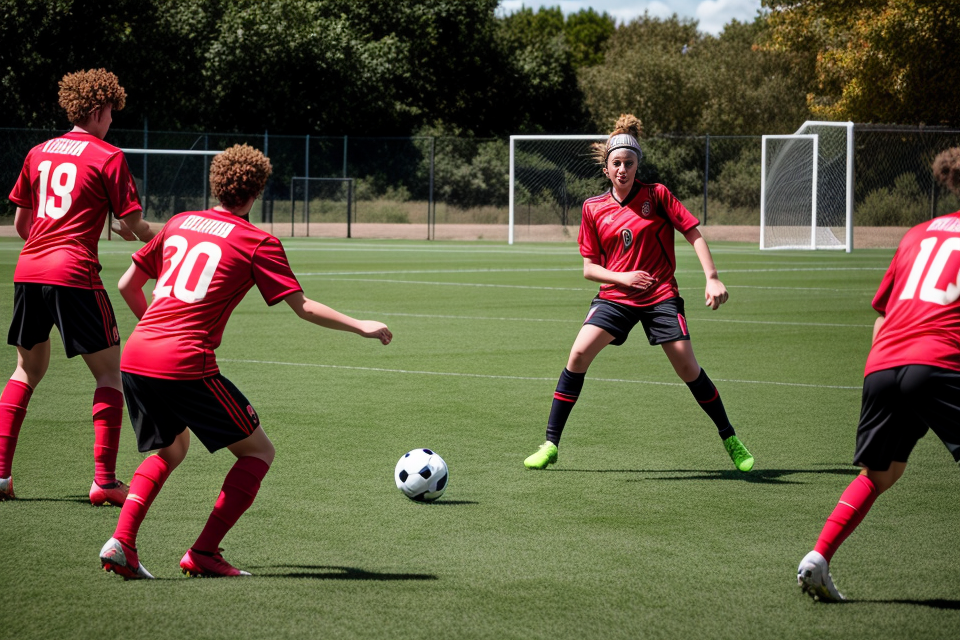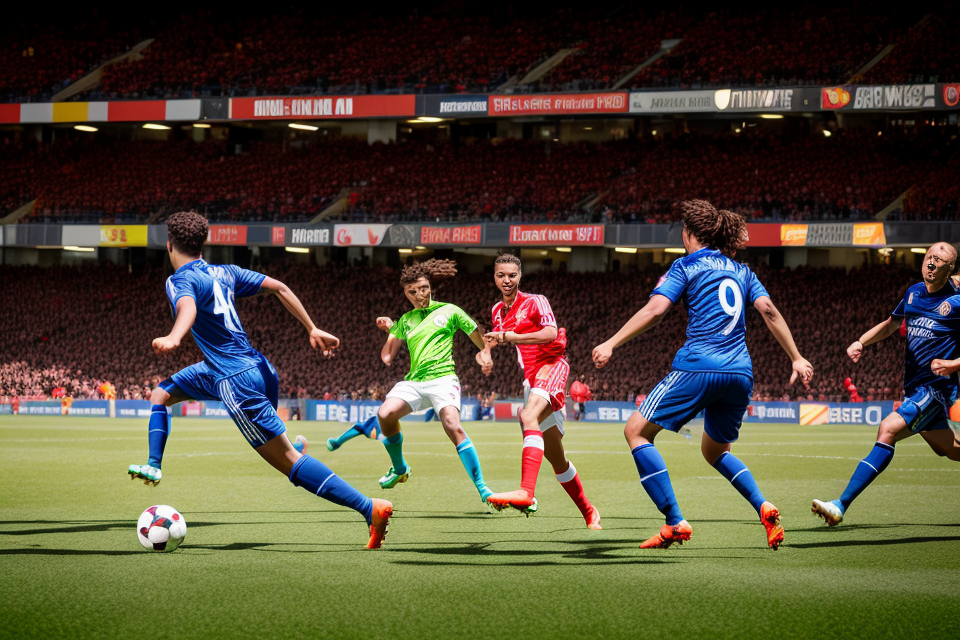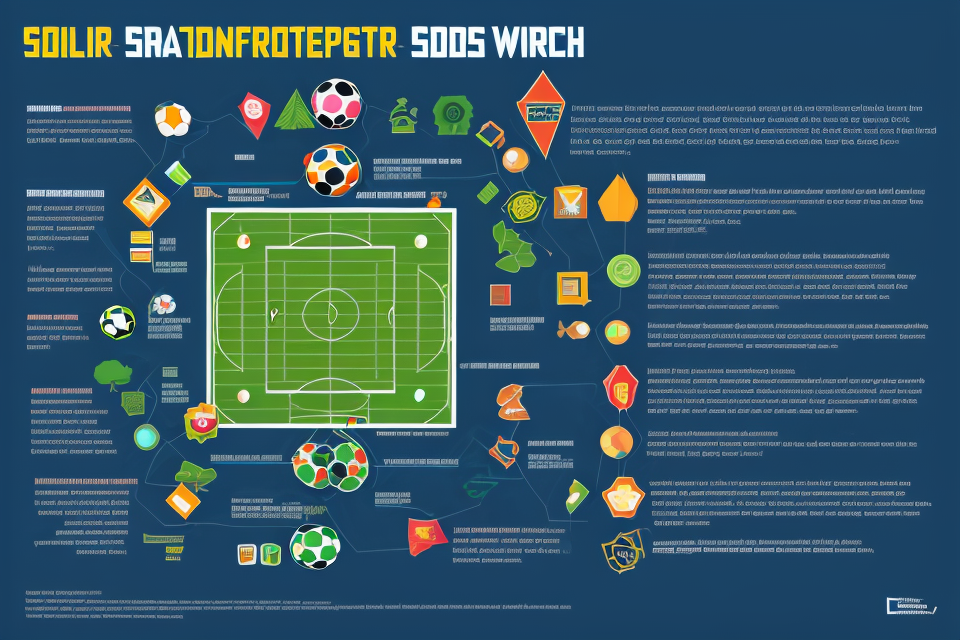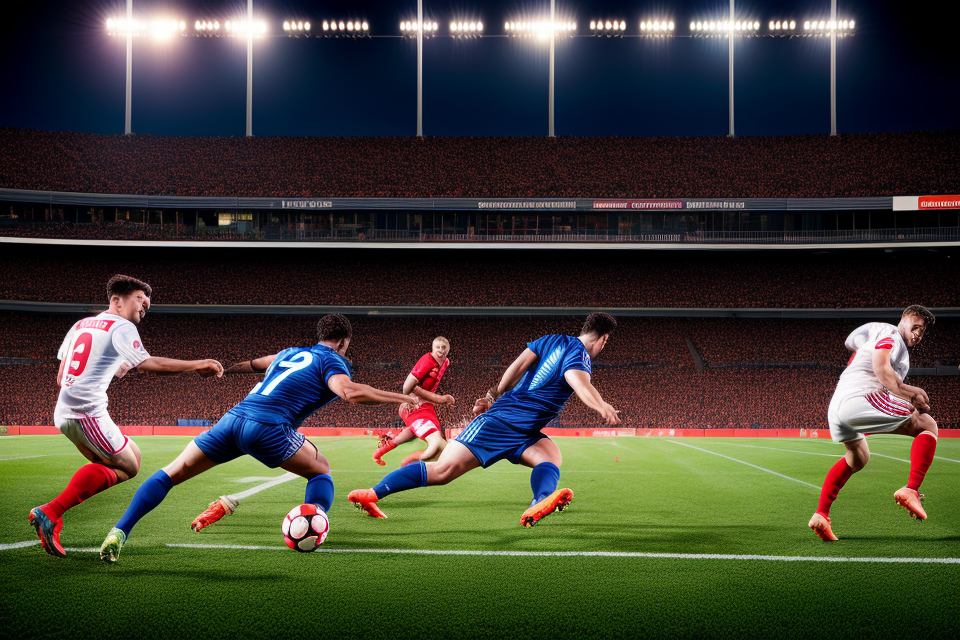Soccer is a game of strategy, where every move counts. One of the most important strategies in soccer is passing. The passing strategy in soccer refers to the way players move the ball from one teammate to another, in order to advance up the field and score goals. This strategy involves not just the player making the pass, but also the player receiving the ball and those around them. A good passing strategy involves precise timing, good communication, and a deep understanding of the game. In this article, we will explore the passing strategy in soccer in detail, including the different types of passes, the importance of passing accuracy, and how to improve your passing skills. So, get ready to learn about the intricacies of passing in soccer and how it can help your team win the game.
The passing strategy in soccer refers to the way that players move the ball from one teammate to another in order to advance the ball up the field and score goals. Effective passing involves a number of different techniques, including short and long passes, as well as diagonal and through-balls. Players must also be aware of their teammates’ positions and movements in order to make accurate and effective passes. The passing strategy is a crucial aspect of soccer, as it allows teams to control the flow of the game and create scoring opportunities.
Understanding the Passing Strategy in Soccer
The Importance of Passing in Soccer
Passing is a fundamental aspect of soccer and plays a crucial role in building attacks, spreading the ball to create space, and supporting teammates. In this section, we will delve into the importance of passing in soccer and how it contributes to the overall success of a team.
Building Attacks
Passing is an essential element in building attacks in soccer. By passing the ball up the field, teams can advance towards the opponent’s goal and create scoring opportunities. A well-executed passing game can help teams maintain possession and control the flow of the match. Effective passing also enables players to move off the ball and create space for their teammates, allowing for more creative and dynamic attacking play.
Spreading the Ball to Create Space
Spreading the ball is a key passing strategy in soccer that helps to create space on the field. By passing the ball to different areas of the field, teams can move the opposition defence and create gaps in their formation. This allows attacking players to exploit these gaps and create shooting opportunities or find teammates in more advantageous positions. Effective spreading of the ball also helps to maintain possession and prevent the opposition from gaining control of the match.
Supporting Teammates
Supporting teammates through passing is another crucial aspect of the passing strategy in soccer. By passing the ball to a teammate in a better position, players can help their teammates to create scoring opportunities and maintain possession. Good passing also allows players to support their teammates defensively by helping to cover gaps in the formation and prevent the opposition from creating scoring chances. Effective support through passing can help teams to work together as a cohesive unit and increase their chances of success on the field.
Types of Passes in Soccer
Soccer is a game that involves a lot of passing, and there are several types of passes that players can use to move the ball up the field. Here are some of the most common types of passes in soccer:
Short Passes
Short passes are used to move the ball a short distance, usually within the same line of players. These passes are typically made to a teammate who is in close proximity, and they are used to maintain possession of the ball or to advance it slightly up the field. Some examples of short passes include:
- Inside Pass: This is a pass made to a teammate who is standing nearer to the ball than the player making the pass.
- Outside Pass: This is a pass made to a teammate who is standing farther away from the ball than the player making the pass.
- Back Pass: This is a pass made to a teammate who is behind the player making the pass.
Long Passes
Long passes are used to move the ball a greater distance up the field. These passes are typically made to a teammate who is farther away from the ball, and they are used to break through the opposing team’s defense or to start a counterattack. Some examples of long passes include:
- Through Pass: This is a pass made to a teammate who is in a better position to score a goal.
- Long Ball: This is a pass made to a teammate who is in a more advanced position up the field.
- Lofted Pass: This is a pass made with a lot of height and trajectory, often to a teammate who is in a more advanced position up the field.
Through Passes
Through passes are used to break through the opposing team’s defense and create scoring opportunities. These passes are typically made to a teammate who is in a better position to score a goal, and they require good ball control and timing. Some examples of through passes include:
- Threaded Pass: This is a pass made through a gap in the opposing team’s defense.
- Split Pass: This is a pass made to a teammate who is making a run between the opposing team’s defense and midfield.
- Cross: This is a pass made across the field to a teammate who is in a better position to score a goal.
Crosses
Crosses are used to deliver the ball into the opposing team’s penalty area and create scoring opportunities. These passes are typically made from the wings or from set pieces, and they require good accuracy and timing. Some examples of crosses include:
- Inswinging Cross: This is a cross that curves into the penalty area.
- Outswinging Cross: This is a cross that curves away from the penalty area.
- Cutback Cross: This is a cross that is played back across the ball towards the goal.
Switches of Play
Switches of play are used to change the point of attack and catch the opposing team off guard. These passes are typically made from one side of the field to the other, and they require good communication and timing. Some examples of switches of play include:
- Simple Switch: This is a pass made from one side of the field to the other, often to a teammate who is in a more advanced position up the field.
- Direct Switch: This is a pass made from one side of the field to the other, often to a teammate who is in a more advanced position up the field.
- Combination Switch: This is a series of passes made from one side of the field to the other, often to catch the opposing team off guard.
Key Elements of a Good Pass
In soccer, passing is a fundamental skill that requires precision and accuracy. A good pass must have several key elements to be successful. Here are some of the most important factors to consider when it comes to making a good pass in soccer:
Accuracy
Accuracy is the most important element of a good pass in soccer. The ball must be directed towards the intended target with precision and accuracy. This requires a player to have excellent vision, control, and ball skills.
Timing
Timing is also crucial when it comes to making a good pass in soccer. The pass must be made at the right time to allow the receiver to control the ball and avoid being tackled by the opposing team.
Weight
Weight is another important factor to consider when making a good pass in soccer. The pass must have the right amount of weight to allow the receiver to control the ball easily. A ball that is too heavy or too light can be difficult to control.
Vision
Vision is a critical element of a good pass in soccer. A player must be able to see the field clearly and anticipate the movements of their teammates and opponents. This allows them to make accurate and timely passes that help the team advance the ball.
First touch
Finally, the first touch is an essential element of a good pass in soccer. The receiver must be able to control the ball immediately after receiving it, and this requires good ball control skills. A good first touch can make all the difference in a game, as it allows the receiver to quickly turn and attack the opposing team.
Common Passing Mistakes to Avoid
One of the most important aspects of passing in soccer is avoiding common mistakes that can hinder the effectiveness of the team’s passing strategy. Here are some of the most common passing mistakes that players should avoid:
Over-dribbling
Over-dribbling is a mistake that occurs when a player tries to dribble the ball too much, instead of passing it to a teammate. This can slow down the pace of the game and disrupt the team’s passing strategy. Over-dribbling can also make it easier for the opposing team to steal the ball and create scoring opportunities.
Lack of vision
Lack of vision is another common mistake that can hinder the effectiveness of a team’s passing strategy. Players who lack vision may not see their teammates or the opposing players, which can lead to poor passes or missed opportunities. Players should work on developing their vision and awareness on the field to improve their passing.
Poor weight
Poor weight is a term used to describe the way a player weights their passes. A player who weights their passes poorly may not be able to accurately deliver the ball to their teammates, which can lead to turnovers and scoring opportunities for the opposing team. Players should focus on using the right amount of weight on their passes to ensure they are accurate and effective.
Inconsistent passing
Inconsistent passing can be a major issue for teams, as it can disrupt the flow of the game and make it difficult for players to anticipate each other’s movements. Players should work on developing consistent passing patterns and establishing a clear passing strategy to help ensure that they are able to move the ball effectively up the field.
Lack of support
Finally, a lack of support from teammates can also hinder the effectiveness of a team’s passing strategy. Players should work on communicating with their teammates and establishing clear passing lanes to help ensure that they are able to move the ball effectively up the field. Additionally, players should be aware of their teammates’ movements and positioning on the field to ensure that they are able to provide support when needed.
Executing the Passing Strategy in Soccer
Warm-up Drills for Passing
Effective passing is crucial to the success of any soccer team. Before beginning any practice or game, it is important to warm up the players’ passing skills. The following are some warm-up drills that can be used to improve passing accuracy and speed:
Short passing
Short passing drills are designed to improve players’ ability to pass the ball quickly and accurately to their teammates within a short distance. This is especially useful when the team is trying to move the ball up the field quickly. One simple drill is to have players line up in two rows facing each other, with one player in the middle. The player in the middle passes the ball to one of the players in the first row, who then passes it back to the middle player, and so on.
Long passing
Long passing drills are used to improve players’ ability to pass the ball over longer distances. This is important when the team needs to move the ball up the field quickly or when the team is trying to score a goal from a long distance. One example of a long passing drill is to have players line up in two rows facing each other, with one player in the middle. The player in the middle passes the ball to one of the players in the second row, who then passes it to another player in the second row, and so on, until the ball reaches the end of the line.
Crossing
Crossing drills are used to improve players’ ability to pass the ball from one side of the field to the other. This is important when the team is trying to score a goal from a wide position. One example of a crossing drill is to have players line up on one side of the field, with one player in the middle. The player in the middle passes the ball to one of the players on the opposite side of the field, who then passes it back to the middle player, and so on.
First touch drills are used to improve players’ ability to control the ball after it has been passed to them. This is important because it allows players to quickly move the ball up the field or to take a shot on goal. One example of a first touch drill is to have players line up in two rows facing each other. The player in the middle passes the ball to one of the players in the first row, who then tries to control the ball with their first touch before passing it back to the middle player.
Building a Passing Rhythm
One of the key elements of a successful passing strategy in soccer is building a passing rhythm. This involves creating a flow of short and long passes that keeps the ball moving forward and allows the team to maintain possession.
Combining short and long passes
Combining short and long passes is an important aspect of building a passing rhythm. Short passes are used to keep the ball moving quickly within the team, while long passes are used to switch play and move the ball up the field. A good passing strategy will combine these two types of passes to keep the opposition off balance and create scoring opportunities.
Switching play
Switching play is another important element of building a passing rhythm. This involves passing the ball from one side of the field to the other, or from one half of the field to the other, to create new attacking opportunities. Switching play can catch the opposition off guard and create spaces for the team to exploit.
Quick passing
Quick passing is also crucial in building a passing rhythm. This involves passing the ball quickly and accurately, without giving the opposition time to react. Quick passing can create confusion in the opposition’s defense and lead to scoring opportunities.
Supporting teammates is a key aspect of building a passing rhythm. This involves moving off the ball and supporting teammates who have the ball. Supporting teammates creates space for the ball carrier and allows the team to maintain possession. A good passing strategy will involve all players supporting their teammates and moving off the ball to create new attacking opportunities.
Tactical Adjustments for Passing
When it comes to executing a passing strategy in soccer, tactical adjustments are crucial for success. These adjustments allow teams to adapt to different game situations and take advantage of their opponents’ weaknesses. Here are some key tactical adjustments for passing in soccer:
Playing with different formations
One of the most significant tactical adjustments a team can make is changing their formation. For example, a team may start the game in a 4-4-2 formation but switch to a 3-5-2 formation if they are behind in the game and need to add an extra defender. This change in formation can help the team better defend against the opposition’s attacks and also provide more options for passing and attacking.
Adjusting to the opposition
Another important tactical adjustment is adjusting to the opposition’s strengths and weaknesses. For example, if a team is facing a strong opposing midfield, they may decide to focus on playing long balls over the top of the midfield to bypass them and get the ball to their forwards. On the other hand, if a team is facing a weak opposing defense, they may choose to play short passes and build up possession in the midfield to exploit the weaknesses in the defense.
Making changes in-game
In addition to making changes in formation and adjusting to the opposition, teams may also need to make changes in-game based on the flow of the match. For example, if a team is winning and wants to maintain their lead, they may choose to play more defensively and rely on counter-attacks. Conversely, if a team is losing and needs to score quickly, they may choose to take more risks and play more aggressively.
Reacting to game situations
Finally, a key aspect of executing a passing strategy in soccer is reacting to game situations. This means being able to quickly adapt to changes in the game, such as injuries, red cards, or changes in weather conditions. For example, if a team loses one of their key midfielders to an injury, they may need to adjust their formation and tactics to compensate for the loss. By reacting quickly and effectively to game situations, teams can improve their chances of success on the pitch.
Mental Aspects of Passing
In order to execute a successful passing strategy in soccer, it is essential to consider the mental aspects of passing. These aspects include focus and concentration, confidence, decision-making, and communication.
Focus and Concentration
Having a clear focus and concentration is crucial for a successful passing strategy in soccer. Players must be fully aware of their surroundings and be able to anticipate the movements of their teammates and opponents. They must also be able to filter out distractions and stay focused on the task at hand.
One way to improve focus and concentration is through visualization techniques. Players can visualize themselves making successful passes and scoring goals, which can help them stay focused and motivated during the game.
Confidence
Confidence is another important mental aspect of passing in soccer. Players must believe in their ability to make successful passes and have faith in their teammates to do the same. Confidence can be improved through repetition and practice, as well as through positive reinforcement from coaches and teammates.
In addition, players must be able to bounce back from mistakes and not let them affect their confidence. This requires a growth mindset and the ability to learn from mistakes and use them as opportunities for improvement.
Decision-Making
Good decision-making is crucial for a successful passing strategy in soccer. Players must be able to quickly assess the situation and make split-second decisions about where to pass the ball. This requires excellent awareness of the game and the ability to anticipate the movements of teammates and opponents.
Players can improve their decision-making skills through practice and analysis of their performance. They can also learn from the decision-making of more experienced players and seek feedback from coaches and teammates.
Communication
Communication is another important mental aspect of passing in soccer. Players must be able to communicate effectively with their teammates, both on and off the field. This includes communicating their intentions when making a pass, as well as providing feedback to their teammates.
Effective communication can be improved through practice and feedback from coaches and teammates. Players can also work on their nonverbal communication skills, such as body language and eye contact, to better convey their intentions and emotions on the field.
Key Takeaways
The passing strategy is a vital aspect of soccer, as it enables players to control the ball, maintain possession, and create scoring opportunities. In order to execute a successful passing strategy, it is essential to understand the different types of passes and their proper execution.
There are several types of passes in soccer, including short passes, long passes, through passes, crosses, and switches of play. Each type of pass serves a specific purpose and requires a different set of skills and techniques to execute accurately.
A good pass should be accurate, timed, weighted, and have vision. Accuracy is crucial, as it ensures that the ball reaches the intended target. Timing is important as it allows the player to release the ball at the right moment to maintain possession or create space. Weighting the pass refers to the speed and strength of the pass, which should be adjusted according to the situation and the skill level of the intended receiver. Vision is also critical, as it enables the player to see the field and identify potential passing options.
Common mistakes in passing include over-dribbling, lack of vision, poor weight, inconsistent passing, and lack of support. Over-dribbling can lead to loss of possession and disrupt the passing rhythm. Lack of vision can result in missed passing opportunities and a failure to connect with teammates. Poor weight can lead to inaccurate passes and turnovers. Inconsistent passing can result in confusion and disorganization on the field. Lack of support can leave players without adequate options for passing and lead to lost possession.
Warm-up drills and building a passing rhythm can improve passing skills. These drills can help players develop the necessary techniques and build muscle memory for executing different types of passes. Additionally, they can help players improve their vision and awareness of their teammates’ movements on the field.
Tactical adjustments and mental aspects of passing are crucial for success in soccer. Players must be able to adapt their passing strategy based on the game situation and the opposing team’s tactics. Mental preparation and focus are also essential, as players must be able to make quick decisions and execute passes accurately under pressure.
FAQs
1. What is the passing strategy in soccer?
The passing strategy in soccer refers to the way players move the ball from one teammate to another, either by kicking it or by throwing it, with the aim of advancing the ball towards the opponent’s goal. A good passing strategy involves quick and accurate passing, proper ball control, and proper communication among teammates.
2. Why is passing important in soccer?
Passing is an essential aspect of soccer as it helps the team to maintain possession of the ball, create scoring opportunities, and move the ball up the field. Good passing also helps to create space and confusion among the opponents, which can lead to opportunities for the attacking team.
3. What are the different types of passes in soccer?
There are several types of passes in soccer, including short passes, long passes, through passes, crosses, and volleys. Each type of pass has its own specific purpose and requires different techniques and skills to execute effectively.
4. How do players practice passing in soccer?
Players can practice passing in soccer by performing various drills that focus on ball control, accuracy, and timing. These drills can include passing in small groups, working on specific types of passes, and incorporating passing into scrimmages or small-sided games.
5. What is the role of communication in passing strategy in soccer?
Communication is a crucial aspect of passing strategy in soccer. Players must communicate with each other to ensure that they are on the same page and to coordinate their movements on the field. This communication can include verbal cues, hand signals, and body language, and it helps to ensure that the team is working together towards a common goal.



